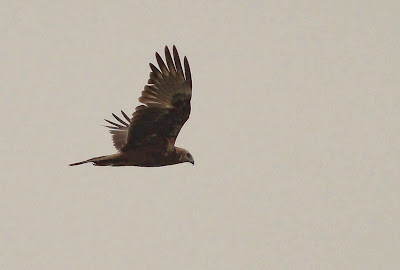 I saw again the immature (supposed 2nd winter) Pied Harrier I photographed last week, but from another angle. This guy show a black patch on the upper back, not easy to see, and a smallest one on the right wing. Now, I am not sure it is a female any more... Look at this link.
I saw again the immature (supposed 2nd winter) Pied Harrier I photographed last week, but from another angle. This guy show a black patch on the upper back, not easy to see, and a smallest one on the right wing. Now, I am not sure it is a female any more... Look at this link. Hovering over a young banana plantation
Hovering over a young banana plantation
 I spotted also 2 immatures Eastern Marsh Harriers. The first one show a large pale area on the breast. I take this to be a first winter bird, which have start molting the tail.
I spotted also 2 immatures Eastern Marsh Harriers. The first one show a large pale area on the breast. I take this to be a first winter bird, which have start molting the tail.

 The remiges of the second one looked fresh and uniform, suggesting that these were juvenile feathers. It didn't appeared to be in wing moult, as one would expect in 2nd winter birds. So, again a 1st winter bird? I am not completely convinced.
The remiges of the second one looked fresh and uniform, suggesting that these were juvenile feathers. It didn't appeared to be in wing moult, as one would expect in 2nd winter birds. So, again a 1st winter bird? I am not completely convinced.
Apparently, Eastern Marsh Harriers take 4 years to reach adult plumage!
 Eastern Marsh have a distinctively long head projection and powerful bill compared to Pied Harriers (impression of "pointed head" - rounded in the case of the Pied)
Eastern Marsh have a distinctively long head projection and powerful bill compared to Pied Harriers (impression of "pointed head" - rounded in the case of the Pied) 
 This Lesser Coucal was foraging in tall grass
This Lesser Coucal was foraging in tall grass
 Yellow-bellied Prinias were singing everywhere
Yellow-bellied Prinias were singing everywhere
 Amongst all the resident birds of this patch, the Barred Buttonquail is one of the most secretive and difficult to observe (but easy to see, it's the paradox! One bird flushed almost on each visit!). If frightened, it will usually squat, immobile, and if approached closely it will flush almost at your feet.
Amongst all the resident birds of this patch, the Barred Buttonquail is one of the most secretive and difficult to observe (but easy to see, it's the paradox! One bird flushed almost on each visit!). If frightened, it will usually squat, immobile, and if approached closely it will flush almost at your feet.
 Good views are hard to come by, so I was happy to have had this brief opportunity. Those photos were just a stroke of good fortune (the second time in 2 years at this patch with this species!)...
Good views are hard to come by, so I was happy to have had this brief opportunity. Those photos were just a stroke of good fortune (the second time in 2 years at this patch with this species!)... Buttonquails have reversed sex roles: the females (distinguished by a black throat patch) are larger and polyandrous. The male incubates the eggs and raises the chicks alone :(
Buttonquails have reversed sex roles: the females (distinguished by a black throat patch) are larger and polyandrous. The male incubates the eggs and raises the chicks alone :(  Green Sandpiper. Rotate this pic 180 degrees : same same!
Green Sandpiper. Rotate this pic 180 degrees : same same!
 The Little Ring Plovers have probably start to breed along the channel. Last year in March I saw there a newly hatched chick
The Little Ring Plovers have probably start to breed along the channel. Last year in March I saw there a newly hatched chick
 There were also some Citrine Wagtails in varying degrees of summer dress. Two images of the same bird.
There were also some Citrine Wagtails in varying degrees of summer dress. Two images of the same bird.

 A White Wagtail bodybuilder. Ocularis race, far less common than leucopsis in the area (ratio 1 to 10/20??). This guy is ill, its "bull neck" remind me of a White-tailed Robin I saw last year at the Botanical Gardens (link). Maybe they are suffering from the same disease.
A White Wagtail bodybuilder. Ocularis race, far less common than leucopsis in the area (ratio 1 to 10/20??). This guy is ill, its "bull neck" remind me of a White-tailed Robin I saw last year at the Botanical Gardens (link). Maybe they are suffering from the same disease.
Sebastien

Great photos, really like the Buttonquail :)
ReplyDeleteYour photo's just tell me again and again that it does not make sense to carry a camera myself! You cann't beat the professional.
ReplyDeleteJan
Thanks Ha, but female Buttonquails are bad girls!
ReplyDeleteHi Jan, I am just a professional of leisure ;)
If you have a 300-400 mm lens, there is no reason not to get good shots.
Post photos here please, we want to see !
Sebastien
Hi Sebastien, I'm coming out to Hanoi (Jasmine Hotel in Lo Su) from April 3-20, with a few days on Fansipan, a couple of days at Tam Dao, and five nights in the Ba Be area checking on the White-eared Night Herons I found during my BirdLife survey in 2008. I enjoyed birding Red River Island that year; hopefully I'll get the chance to do the same this year. Perhaps we might meet up? David Walsh, davidfwalsh@hotmail.co.uk
DeleteOk David, send me a mail where you are here (sebastiendlngl40@gmail.com)
DeleteCheers,
Sebastien